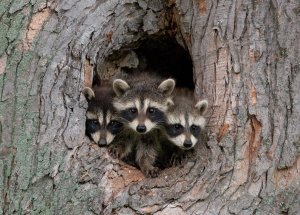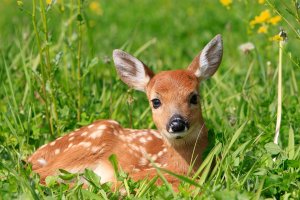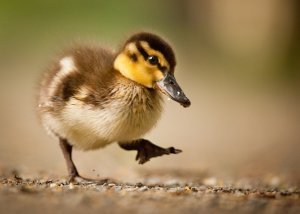Baby Animal Season: Keeping wildlife wild!
April 24, 2024
By Jolene Weick, Park Interpreter
Spring has sprung and that means Mother Nature is showing off her skills again. The trees are finally showing signs of life, the grass is greener, the ephemerals have come and gone, and evidence of a successful breeding season is fully underway. That’s right, babies are popping up everywhere. Fledglings, fawns, bunnies, oh my! With the weather warming up, you may cross paths with a baby animal who may seem a little lost. While your heart may be telling you to pick that baby up and take it into your home, its best to leave it be!

Like in the image above, many animals will hide their young while they’re on the move. They may be out gathering a meal, or simply taking a break from clawing paws. Rest assured; mama will come back. These babies are not abandoned, they do not need rescuing. Interfering with their whereabouts may actually be detrimental to the animal. If you move the baby from the spot where it was left, when mama comes back searching for it, she may not be able to find it. It is best to leave any animal in its natural environment.

Wildlife is meant to stay wild! Keeping a baby animal that you find as a pet may seem like a fun idea but can be very dangerous for you and the animal. When wild animals are frightened and scared, they tend to act unpredictably. Even a baby can be aggressive, and just because it isn’t aggressive at first does not mean it will not become aggressive. Wildlife also carry many diseases that you may not recognize right away. If you, your family, or your pets are exposed to something carried by a wild animal, it could result in life threatening illness.

Common myths about finding baby animals:
Myth: If you touch a baby bird, the mom will smell you on it and not return.
Fact: While you should not be touching wildlife, if you do find a baby bird outside of its nest and place it back in, the mom will not smell you and will return.
Myth: If you find a baby animal, you should give it store bought milk.
Fact: You should never attempt to feed a wild animal anything. The milk you buy at the grocery store is meant for baby cows, it may kill smaller animals. Every mammal species has different nutrient requirements and many species react badly to the milk of other animals
Myth: If you don’t help the baby animal you find, then it will die.
Fact: The baby animal probably wasn’t abandoned in the first place. Leaving it gives it a better chance of survival than attempting to help.
But what if it seems injured or truly ill? Do not attempt to help it yourself. You may provide it water, as it may just be dehydrated, but do not attempt to move or feed it unless instructed by a professional wildlife rehabilitator. You can connect with a professional, licensed wildlife rehabilitator through the list on Michigan Department of Natural Resources’ website.
https://www.michigandnr.com/dlr/
Each rehabilitator is listed by county and specialty. Most rehabilitators will not take birds unless they are raptors (hawks, eagles, owls, etc.) or non-migratory birds. Birds such as ducks, geese, and robins are found in abundance, especially in the springtime, and rescue centers reach capacity for them rather quickly. Most nature centers, including our Metroparks interpretive centers, cannot take in any wildlife. The best chance that injured, sick, or orphaned animals have is to be connected to a licensed rehabilitator with the skills, equipment, and knowledge required to help each species.
Let’s all work to keep wildlife wild and work with permitted, trained rehabilitators when we must intervene. Remember that, most of the time, when we “rescue” a young animal, we may actually be kidnapping it during an important part of it’s learning years!
